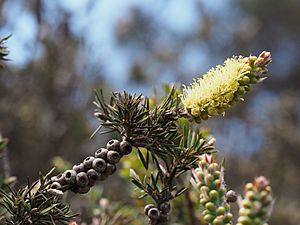Alpine bottlebrush facts for kids
Quick facts for kids Alpine bottlebrush |
|
|---|---|
 |
|
| Melaleuca pityoides leaves, flowers and fruit | |
| Scientific classification | |
| Genus: |
Melaleuca
|
| Species: |
pityoides
|
| Synonyms | |
|
Callistemon pityoides F.Muell. |
|
The alpine bottlebrush, also known as Melaleuca pityoides, is a cool plant from the Myrtaceae family, which is the same family as myrtle. This plant grows naturally only in the higher parts of southeastern Australia. Some plant collections, called herbaria, still use its old name, Callistemon pityoides.
This plant is a shrub that often grows in thick, dense groups. It has tough bark, new leaves that look silvery-grey, and leaves that are almost round like a cylinder. Its flowers grow in spikes and are usually a shade of yellow.
Contents
What Does It Look Like?
The Melaleuca pityoides is a shrub that can grow up to 3 m (10 ft) tall and wide. It has hard, grey bark.
- Its leaves grow one after another along the stem.
- They are about 12–24 mm (0.5–0.9 in) long and 0.5–2.5 mm (0.02–0.1 in) wide.
- The leaves can be flat or almost round.
- They are very narrow and shaped like an egg, ending in a sharp point.
- It's hard to see the veins and oil glands on the leaves.
- Young leaves and branches often have soft, silky hairs.
The flowers are usually golden-yellow to cream, sometimes with a touch of pink or green. They grow in short spikes at the ends of branches. These branches keep growing even after the flowers bloom.
- The flower spikes are about 18–25 mm (0.7–1 in) across and 100 mm (4 in) long.
- Each spike has 10 to 15 individual flowers.
- The petals are about 2.1–3.4 mm (0.08–0.1 in) long and fall off as the flower gets older.
- Each flower has between 32 and 52 stamens, which are the parts that make pollen.
- The plant usually flowers from October to February, but sometimes at other times of the year.
- After flowering, it produces woody seed pods, called capsules, which are about 3.2–5.1 mm (0.1–0.2 in) long.
How It Got Its Name
This plant was first officially described in 1883 by a botanist named Ferdinand von Mueller. He worked for the Victorian Government and named it Callistemon pityoides. He based this name on plants he found near the Ovens River and "Dumaresque River."
Mueller had actually mentioned the name Melaleuca pithyoides without a full description back in 1853. This was in his report about the plants in the colony. He had collected parts of the plant, but not flowers, from Mount Buffalo National Park earlier that year.
The name was changed to Melaleuca pityoides in 2006 by another botanist, Lyndley Craven. The second part of its name, pityoides, comes from two Greek words:
- pitys, which means "pine"
- eîdos, which means "likeness"
This name was chosen because the leaves of the alpine bottlebrush look a bit like the leaves of some pine trees.
Where It Grows
This type of Melaleuca plant grows in several parts of eastern Australia. You can find it from the Border Ranges National Park in southeastern Queensland, all the way south through the Northern, Central, and Southern Tablelands of New South Wales. It also grows in the highlands of eastern Victoria.
It likes to grow in wet, swampy areas with heath plants, or near rocky streams. It often forms thick groups, sometimes so dense that other plant species can't grow there.
Growing It in Gardens
People sometimes grow Melaleuca pityoides in gardens. It's sometimes still called Callistemon pityoides when sold for gardening. This plant grows well in cold places, even in the United Kingdom. It prefers heavier soils and can handle areas where water doesn't drain away too quickly.
Gallery
-
M. pityoides thicket near New England National Park
-
M. pityoides thicket in Baw Baw National Park
Images for kids
-
Habit in the Torrington State Conservation Area




